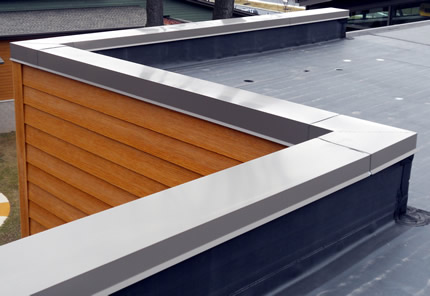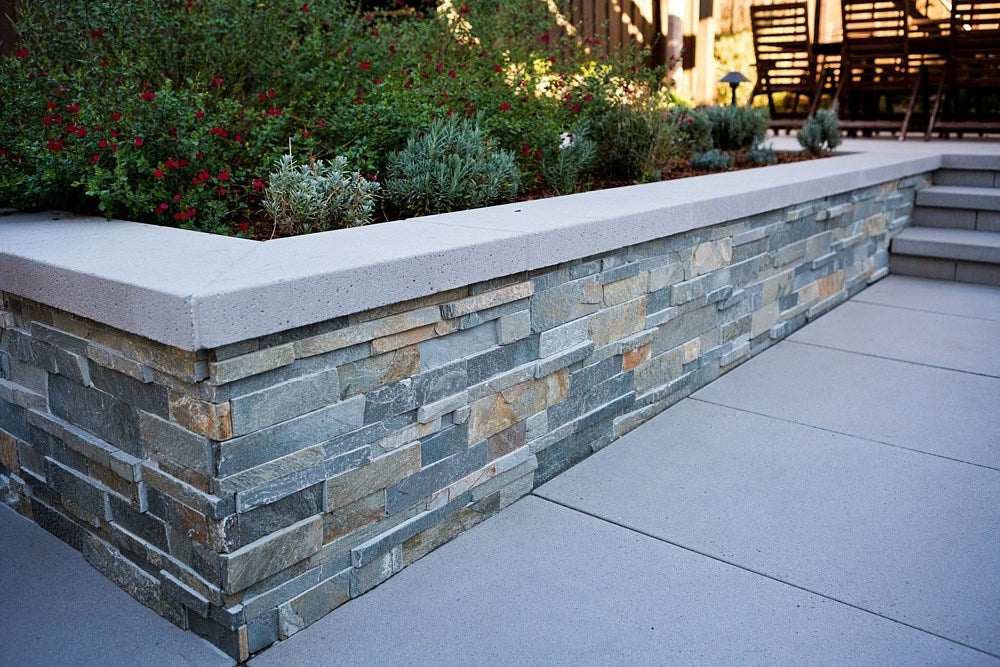When it comes to finishing your walls with a touch of elegance and durability, the choice of wall cappings or copings can make all the difference. These crucial elements not only protect your walls from weather damage but also add a refined aesthetic to your property. But with a myriad of options like concrete, granite, porcelain, and more, how do you determine which material is the best fit for your needs? Let's delve into the world of wall cappings and uncover the perfect choice for your next project.
Concrete Wall Cappings

Concrete wall cappings are a popular choice due to their durability and versatility. These cappings are made from a mixture of cement, sand, and aggregates, which makes them incredibly strong and long-lasting. They can withstand harsh weather conditions, making them ideal for both residential and commercial properties.
Concrete cappings come in a variety of shapes and sizes, allowing for customisation to fit the specific design of your wall. Additionally, they can be textured or coloured to match or complement the overall aesthetic of your property. One of the key benefits of concrete is its cost-effectiveness, providing a durable solution without breaking the bank. Moreover, concrete is low maintenance, requiring only occasional cleaning to keep it looking its best.
Granite Wall Cappings

Granite wall cappings are renowned for their unmatched durability and timeless beauty. As a natural stone, granite offers a luxurious and sophisticated look that can elevate the appearance of any property. Known for its strength and resistance to weathering, granite is an excellent choice for wall cappings that need to endure extreme weather conditions without deteriorating.
Granite comes in a variety of colours and patterns, each piece unique, providing a bespoke look to your walls. The natural veining and speckling in granite add a layer of elegance that artificial materials often cannot replicate. Additionally, granite is highly resistant to scratches, stains, and heat, ensuring that it remains pristine over time with minimal maintenance.
While granite is more expensive than other capping materials, its longevity and aesthetic appeal make it a worthwhile investment. The installation of granite cappings requires precision and expertise, often necessitating professional installation to achieve the best results. For homeowners and businesses looking to make a lasting impression, granite wall cappings are an excellent choice that combines beauty with robust performance.
Porcelain Wall Cappings

Porcelain wall cappings are gaining popularity for their sleek appearance and impressive durability. Made from a dense, non-porous ceramic material, porcelain is incredibly hard and resistant to weathering, making it an excellent choice for exterior applications.
One of the standout features of porcelain cappings is their resistance to stains, moisture, and temperature fluctuations. This makes them particularly suitable for areas that experience harsh weather conditions, as they won’t crack or discolour over time. Additionally, porcelain is resistant to UV radiation, which means it maintains its colour and finish even after prolonged exposure to sunlight.
Porcelain cappings come in a wide variety of colours, textures, and finishes, including options that mimic the look of natural stone, wood, or even metal. This versatility allows for greater design flexibility, enabling homeowners and designers to achieve the desired aesthetic for their walls. Furthermore, porcelain is relatively low maintenance, requiring only periodic cleaning to keep it looking its best.
While porcelain cappings can be more expensive than concrete, their long lifespan and minimal maintenance needs often justify the initial investment. They are also lightweight compared to natural stone, which can simplify the installation process. For those seeking a modern, high-performance solution, porcelain wall cappings offer a perfect blend of style and functionality.
Weathered Wall Cappings

Weathered wall cappings offer a unique and rustic charm that can add character and depth to any property. These cappings are designed to mimic the appearance of naturally aged materials, providing an instant vintage appeal without the wait for natural aging. This makes them ideal for both traditional and contemporary architectural styles that seek a touch of historical elegance.
Weathered cappings can be made from various materials, including concrete, stone, and even metals that have been treated to achieve an aged look. The weathering process involves techniques such as acid washing, sandblasting, or applying special coatings to create a distressed and antique appearance. This process not only enhances the visual appeal but also adds a layer of protection against the elements.
One of the key benefits of weathered wall cappings is their ability to blend seamlessly with existing structures, particularly in renovation projects where a harmonious integration with old materials is desired. The naturally aged look can enhance the aesthetic value of garden walls, patios, and outdoor living spaces, creating a timeless and inviting atmosphere.
Weathered wall cappings are available in various colours and textures, allowing for customisation to suit different design preferences. Whether you prefer the rugged look of aged stone or the subtle elegance of weathered metal, these cappings can be tailored to match your specific vision.
Maintenance for weathered wall cappings involves regular cleaning to remove dirt and prevent the buildup of moss and algae. While the initial weathering treatment provides a level of protection, periodic inspections and touch-ups may be necessary to maintain their appearance and structural integrity.
Weathered wall cappings are an excellent choice for those looking to add a historical touch to their property while benefiting from the durability and practicality of modern materials. Their unique aesthetic and ability to blend with various architectural styles make them a versatile and appealing option for any wall capping project.
Natural Slate Wall Cappings

Natural slate wall cappings bring an elegant and sophisticated look to any property, combining durability with timeless beauty. Known for its fine-grained texture and rich, natural colours, slate is a versatile material that enhances the aesthetic appeal of both traditional and contemporary architectural styles.
Natural slate is a metamorphic rock formed under intense heat and pressure, resulting in a dense and durable material that is resistant to weathering. Slate comes in a variety of colours, including shades of grey, black, green, and purple, with unique veining and textures that add character to each piece. This variety allows homeowners and designers to choose a shade that best complements their existing structures and landscape.
One of the key advantages of natural slate is its long lifespan. Slate is highly resistant to water absorption, which helps prevent damage from freeze-thaw cycles and reduces the risk of cracking. Its natural composition makes it resistant to mould, mildew, and insect damage, ensuring that it remains in excellent condition for decades.
Natural slate wall cappings can be cut and shaped into various profiles and sizes, allowing for customised cappings that fit specific design requirements. While slate is relatively heavy and requires professional installation to ensure proper support and alignment, its durability and low maintenance needs make it a worthwhile investment.
Maintenance for natural slate is minimal, typically involving occasional cleaning to remove dirt and debris. The natural patina that develops over time can enhance the slate's appearance, adding to its charm and character. For those seeking a high-quality, long-lasting solution, natural slate wall cappings offer a perfect blend of functionality and aesthetic appeal.
Brick Wall Cappings

Brick wall cappings provide a classic and enduring look that complements a variety of architectural styles. Made from fired clay, brick cappings are known for their durability, strength, and timeless appeal. They are an excellent choice for homeowners looking to achieve a traditional or rustic aesthetic for their walls.
Brick cappings are available in a range of colours, from the classic red and brown hues to more contemporary shades like grey and cream. This variety allows for customisation to match or contrast with the existing brickwork or other elements of the property. Bricks can be arranged in various patterns, adding a decorative touch to the wall while providing functional protection.
One of the key benefits of brick wall cappings is their durability. They are resistant to weathering, fire, and insects, making them a long-lasting solution for exterior walls. Additionally, bricks have good thermal mass, helping to regulate temperature by absorbing heat during the day and releasing it at night. This can contribute to the energy efficiency of the building.
Installation of brick cappings involves placing the bricks on top of the wall and securing them with mortar. This process is straightforward but requires skilled labour to ensure proper alignment and stability. Once installed, brick cappings require minimal maintenance, typically involving only periodic cleaning to remove dirt and moss.
Brick cappings are an affordable option that offers both aesthetic and practical benefits, making them a popular choice for a wide range of applications, from residential garden walls to commercial properties.
Metal Wall Cappings

Metal wall cappings offer a sleek, modern look and exceptional durability, making them an excellent choice for contemporary architectural styles and commercial properties. Typically made from materials like aluminium, stainless steel, or zinc, metal cappings provide a robust and long-lasting solution that requires minimal maintenance.
One of the primary advantages of metal wall cappings is their resistance to weathering and corrosion. Metals like aluminium and stainless steel are highly resistant to rust and can withstand extreme weather conditions, including heavy rain, snow, and intense sunlight. Zinc, in particular, develops a protective patina over time, which not only enhances its appearance but also provides additional protection against the elements.
Metal cappings are available in various finishes, including brushed, polished, and powder-coated, allowing for a range of aesthetic options. These finishes can be customised to match the design of the building, whether it’s a sleek, industrial look or a more refined, polished appearance. Additionally, metal cappings can be fabricated in different profiles and sizes to fit specific design requirements, providing both functional protection and visual appeal.
Installation of metal wall cappings typically involves securing the metal sheets to the top of the wall using brackets or adhesives. This process requires precision and expertise to ensure a seamless fit and long-lasting performance. Once installed, metal cappings require very little maintenance, usually just periodic cleaning to maintain their appearance.
While metal wall cappings can be more expensive than other materials, their longevity and minimal maintenance needs often justify the initial investment. They are particularly well-suited for modern buildings and commercial properties where a clean, contemporary look is desired.
Comparative Analysis of Wall Cappings: Pros and Cons
To help you make an informed decision, here's a detailed comparative analysis of various wall capping materials, highlighting their pros and cons:
|
Material |
Pros |
Cons |
|
Concrete |
- Durable and long-lasting - Cost-effective- Versatile in shapes and sizes - Low maintenance |
- Can be prone to cracking - Requires professional installation for best results |
|
Granite |
- Extremely durable - Timeless beauty and unique appearance - Resistant to weathering and scratches - Low maintenance |
- High initial cost - Heavy, requiring reinforced structures - Professional installation needed |
|
Porcelain |
- Highly durable - Resistant to stains, moisture, and UV radiation - Wide range of colours and finishes - Low maintenance |
- Higher cost compared to concrete - Requires precise installation - Can be slippery when wet |
|
Weathered |
Unique rustic charm Blends well with existing structures Customisable colours and textures Durable and protective |
Requires regular cleaning Periodic touch-ups may be needed Initial weathering treatment adds to cost |
|
Natural Slate |
Elegant and sophisticated look Highly durable and long-lasting Resistant to weathering, mould, and insects - Low maintenance |
High initial cost Heavy, requiring reinforced structures Professional installation needed |
|
Brick |
- Classic and traditional look - Durable and fire-resistant - Affordable and widely available |
- Can be heavy - Requires periodic cleaning and maintenance - Susceptible to mortar deterioration |
|
Metal |
- Sleek and modern appearance - Highly durable and weather-resistant - Low maintenance |
- Higher initial cost - Can be prone to dents and scratches - Requires professional installation |
Installation and Maintenance of Wall Cappings
Installation
The installation process of wall cappings varies depending on the material chosen. However, there are some common steps and considerations to keep in mind:
Preparation: The wall surface must be clean, dry, and free of any debris or loose materials. Any existing damage to the wall should be repaired before installing the cappings.
Measuring and Cutting: Accurate measurements are crucial to ensure the cappings fit perfectly. For materials like concrete, granite, and porcelain, precise cutting tools are required to achieve clean edges. Metal cappings are typically prefabricated to the desired dimensions.
Applying Adhesive or Mortar: Depending on the material, an appropriate adhesive or mortar is applied to the wall surface or the underside of the cappings. This helps secure the cappings in place and provides a strong bond.
Placement and Alignment: The cappings are carefully placed on top of the wall, ensuring proper alignment, and spacing. For materials like brick and concrete, additional mortar may be used between joints to secure the cappings and enhance stability.
Sealing and Finishing: For porous materials such as limestone and sandstone, a sealant is applied to protect against moisture and staining. Metal cappings may receive a protective coating to enhance their weather resistance.
Curing and Setting: Adequate time is allowed for the adhesive or mortar to cure and set. This ensures that the cappings are firmly attached and ready to withstand environmental conditions.
Maintenance
Proper maintenance is essential to preserve the appearance and functionality of wall cappings. Here are some maintenance tips for different materials:
Concrete: Clean periodically with mild detergent and water to remove dirt and algae. Inspect for cracks or chips and repair promptly to prevent further damage.
Granite: Regularly clean with a soft cloth and pH-neutral cleaner. Avoid using harsh chemicals that can damage the surface. Seal periodically to maintain its lustre and protect against stains.
Porcelain: Clean with mild detergent and water. Porcelain is low maintenance but should be inspected for any signs of damage, especially after severe weather.
Weathered: Regularly clean to prevent dirt and algae buildup. Inspect for any areas needing touch-ups and reapply weathering treatment as necessary to maintain appearance.
Natural Slate: Clean with a soft brush and water to remove dirt and moss. Apply a sealant periodically to protect against moisture and staining. Inspect for signs of erosion and address any issues promptly.
Brick: Clean with a gentle brush and water to remove dirt and moss. Inspect for cracks in the mortar and repair as needed. Brick is generally low maintenance but should be monitored for signs of wear.
Metal: Clean with a soft cloth and water to remove dirt and debris. Inspect for signs of rust or corrosion and address any issues promptly. Metal cappings are low maintenance but may require occasional resealing of joints.
Comprehensive Care for Your Wall Cappings
Selecting the appropriate wall capping material is crucial for both the protection and aesthetic enhancement of your walls. Concrete, granite, porcelain, weathered, natural slate, brick, and metal each offer unique benefits and characteristics that can meet different needs and preferences. Proper installation and maintenance are essential to ensure their long-term performance and aesthetic appeal.
Consulting with a professional installer can help you ensure your wall cappings are properly fitted and maintained. Contact us today to learn more about our wall capping solutions and schedule a consultation for your next project.
Choose your Bitumen Roof Sheets with Roofing Supplies UK
Ready to upgrade? Explore our extensive range of wall cappings at Roofing Supplies UK. Contact us today to find the perfect solution for your needs! Email us at sales@roofingsuppliesuk.co.uk, call us at 01752 466151, or order online 24 hours a day, seven days a week. We’ll be able to help you purchase your wall cappings now.

